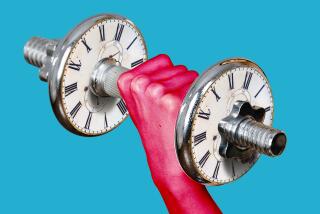Negative training: a positive move for your muscles
- Share via
If you’re just getting into regular weight training, or have hit a plateau in your progress, here’s an offbeat suggestion: Accentuate the negative. You’ll get a positive boost for your workout, and you’ll show up those grunt-and-jerks at the next bench for the ignoramuses they are.
Negative strength training -- also known as negative resistance training (NRT) or eccentric muscle training -- is the yin to the yang of a particular exercise. If you are working your bicep by lifting a dumbbell, for example, you’re using concentric muscle action -- meaning that the muscle is contracting. Eccentric, or negative, action refers to the lengthening of a muscle, as when you lower the weight or allow a machine to retrieve the bar.
The power of negative thinking, so to speak, is based on a little-known fact: A muscle can handle substantially more weight when it’s lengthening than when it’s contracting, when you’re fighting either gravity or the machine’s recoil. The alternate part of the exercise -- the exhale move, the release, the return -- which is so often shrugged off, should really be exploited as a work-down. Practicing controlled returns, with the muscles fully engaged, is like adding an extra set for the opposing muscles without changing machines or moves. (It’s true: Less is more.)
This counterpoint of positive and negative exercise is what makes Pilates so effective as a conditioner; it emphasizes simultaneous concentric and eccentric motion. It’s also the reason that “SuperSlow” training can produce benefits so quickly. SuperSlow, developed in 1982 as part of a program to help women with osteoporosis weight-train more safely, emphasizes a longer, more sustained motion than traditional weight lifting. Instead of curling a bicep in a second or two and releasing it almost as quickly -- in the kind of rhythm you might use when combining light weights with cardio in a sculpting class -- SuperSlow practitioners use a count of 10 for the exertion move and four or five for the return. Some trainers even recommend a 10-and-10 count.
Think it’s a weeny move? Prepare to be humbled. You can’t cheat the weight by jerking or forcing. Slow-regimen training also requires close concentration because, if you let your form slip, you can strain something. So start with a lighter weight and remember to move smoothly, sustain muscle tension (especially in the abs), continue to breathe evenly and keep your shoulders out of your ears.
Research suggests that negative training is less stressful on the body, while paradoxically causing more microscopic muscle tearing. (The latter is a good thing: Because the body sews up these tiny muscle tears with extra stitching, so to speak, the muscle gets stronger.) One study of elderly people that compared traditional and negative training regimens found that eccentric exercise increased strength and improved balance to boot.
There are a couple of ways to use negatives to your advantage. If you have a trainer or training partner, you can work your way up to heavier weights by having your companion help with the “positive” motion, giving you that little extra boost or lift, but completing the return movement on your own.
If you work out alone, try using both arms (or both legs) for the exertion move, but only one for the release. This is primarily for machine work, such as seated chest presses where you can use a pedal to help release the weight, although you can also adapt some elastic cord or free-weight exercise. Some professional weight trainers use a reverse SuperSlow, with a shorter concentric count and a longer release. Again, you should be particularly attentive to form if you do this because there’s a tendency to relax the abs or curve the back if nobody reminds you.
There’s also another type of “negative” exercise. If you’re new to a particular exercise, it might help to start with a reverse version and work up to the conventional form. For example, one of the best ways to strengthen ankles is an old dancer’s exercise for which the traditional starting position is on your toes -- actually, up high on the balls of the feet. From there, you bounce down and back up 20 or 30 times, keeping the legs, ankles and feet all straight. But if the muscles (and tendons) in your feet and legs are too weak to keep your ankles from wobbling, you can start with your feet flat on the floor, rise cleanly (and without letting your ankles bend out) until you’re up as if on stiletto heels, then lower down. As you get stronger, you can do two sets from the down position and one set from the up position, and so on.
Similarly, if you want to start doing full-body push-ups and haven’t found the knees-down position comfortable, try starting on your hands and knees, then extending your legs -- keeping your back plank-straight from shoulder to toes -- and lowering yourself slowly to the floor.
Return to your hands and knees, push up into the plank position and lower yourself again. This is tougher than you think. But eventually you’ll gain enough strength to be able to substitute traditional push-ups and then sets of the real thing.


